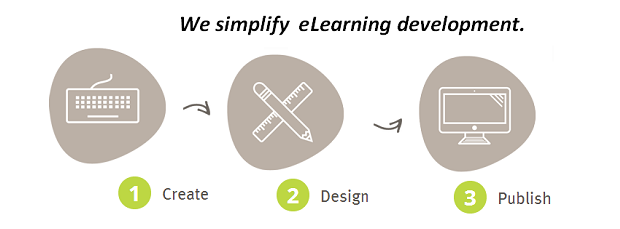* – This article has been archived and is no longer updated by our editorial team –
Below is our recent interview with Kasper Spiro, CEO at Easygenerator:

Q: Can you give us a brief introduction to Easygenerator?
A: Easygenerator is an e-learning authoring tool built to help subject matter experts (SMEs) capture and share their professional expertise. It was developed specifically to promote employee-generated learning (EGL), a model in which any employee can create e-learning courses on topics in which he or she is an expert.
Our SaaS-based product is intended for SMEs instead of instructional designers. Authors simply log in and start using the easy-to-learn features straight away. That means they can instantly focus on content without worrying about complicated design or layout technicalities.
To make things even easier, we are currently building an AI-driven didactical “coach” to accompany the authoring tool. This intelligent coach analyses the author’s work and provides instant advice on how to improve the educational quality of the content.
 Recommended: Mediafolio Technologies Announces General Availability Of SingleStep Intelligent Training Platform
Recommended: Mediafolio Technologies Announces General Availability Of SingleStep Intelligent Training Platform
Q: Why is now the time for a technology solution like Easygenerator?
A: Easygenerator is a product of the age we are living in. This is clear when you look at the prevailing business challenges that prompted us to develop our EGL model and authoring tool in the first place.
The main issue originates from the centralized content development approach adopted by L&D teams. This approach has proven to be slow and expensive and struggles to keep content up to date. The traditional, centralized L&D approach is subject to many limitations and challenges:
Too many regional requests
To keep pace with ever-changing market needs, companies must upskill their employees with unprecedented speed. As a result, L&D teams are bombarded with requests for new training content.
Centralized L&D teams don’t have time to handle smaller, more specialized requests from various regional teams within their organizations. The resources available to L&D are usually insufficient for handling the sheer volume and diversity of training requests they receive.
L&D’s shortage of up-to-date knowledge
L&D departments often lack essential, up-to-date knowledge, leaving them incapable of handling the influx of training requests. This knowledge can only be found in niche areas of the business. Inevitably, L&D relies on subject matter experts (SMEs) working in each field to provide knowledge for the training content. Traditionally, this involves a lot of back and forth communication between L&D and SMEs, resulting in lost time and missed market opportunities.
Tight budgets
Creating and maintaining e-learning modules using a centralized L&D approach or third-party providers is not cost-effective. Faced with increasingly tight budgets, L&D simply cannot afford to create all the new content centrally or outsource content creation to a vendor.
These challenges made us question the viability of conventional training practices. We believe that companies must abandon the old-school top-down, centralized model and switch to a bottom-up, decentralized model instead. We call this new model employee-generated learning (EGL).
Tech intervention
How could technology help implement this new learning model? To answer this question, we looked at how technology could specifically solve the issues listed above. We interviewed potential users (SMEs) who would be responsible for creating learning content. Our research revealed the following pain points that SMEs were experiencing in the process of knowledge sharing. These later helped us define the functionalities and specifications of our authoring tool:
Most SMEs considered content creation to be overly time-consuming.
SMEs relied on Powerpoint presentations as a training medium, but these did not translate into effective e-learning content.
SMEs wanted credit and recognition for their knowledge-sharing efforts.
Existing feature-rich authoring tools created for instructional designers were overly complicated. SMEs could not afford to waste time learning to use these tools. They wanted a really simple authoring tool that would enable them to publish their content right away.
Faced with these issues and requirements, we saw a clear need for a knowledge-sharing product that would support L&D teams in enabling their employees to share expertise.
At the same time, the product had to cater to the needs of busy SMEs who are not professional educators. It needed to allow them to share their knowledge in a meaningful way. Driven by this set of business and technical requirements, we set out on our mission to build an SME-friendly technology solution. This is how Easygenerator was born.
Q: What are the benefits of blended learning?
A: Digitalization has influenced every aspect of our lives and transformed the way we work. It allows us to connect remotely, communicate virtually and work on the go. In light of these changes, classroom training can no longer fulfill all employee upskilling requirements. Therefore, educators in corporate L&D and the academic world are turning to blended learning approaches that allow them to offer the flexibility their learners require.
Surprisingly, many companies have yet to fully embrace the transformation to e-learning and still rely on purely classroom-based training models. A growing number of companies now use Easygenerator to create the knowledge base behind their classroom training. Our tool offers course-hosting and result-tracking features, so it enables clients to shift to a model in which e-learning and classroom training work hand in hand. This is an easy way to make the first step toward online learning. It not only shortens the duration of the classroom training but also improves educational quality and results.
Key Benefits
1. Saves time and money: Probably the biggest benefit of blending classroom training with e-learning is the amount of time and money it saves.
2. Scalability: Blended learning reaches infinitely larger numbers of learners in a virtual space in contrast to the space and planning constraints of classroom-based training.
3. Learner autonomy: e-learning allows learners to train at their own pace and refer back to instructional content whenever they need.
Q: What are your plans for the future?
A: Our mission is to fully support SMEs in sharing their knowledge. Building our authoring tool for SMEs is only the first step for us. Soon, we plan to enrich our product with smart features that proactively nudge and guide SMEs toward creating more meaningful learning content.
We think of this as a didactical “coach” that is powered by artificial intelligence and helps authors make the biggest possible impact with the content they create. This new component will not only make it easy for SMEs to capture their knowledge, but will also enhance the quality and improve the effectiveness of the content. Our vision is to make our product more proactive so it can guide authors to make the best choices.
Activate Social Media:


